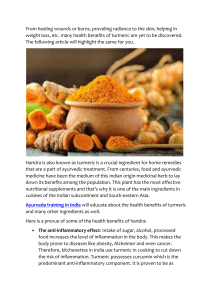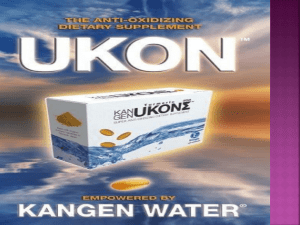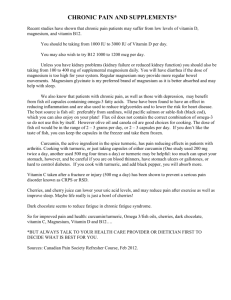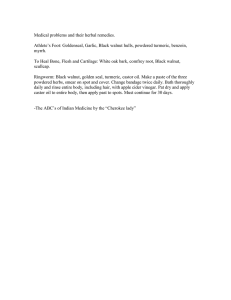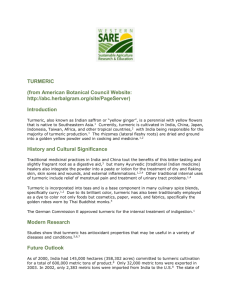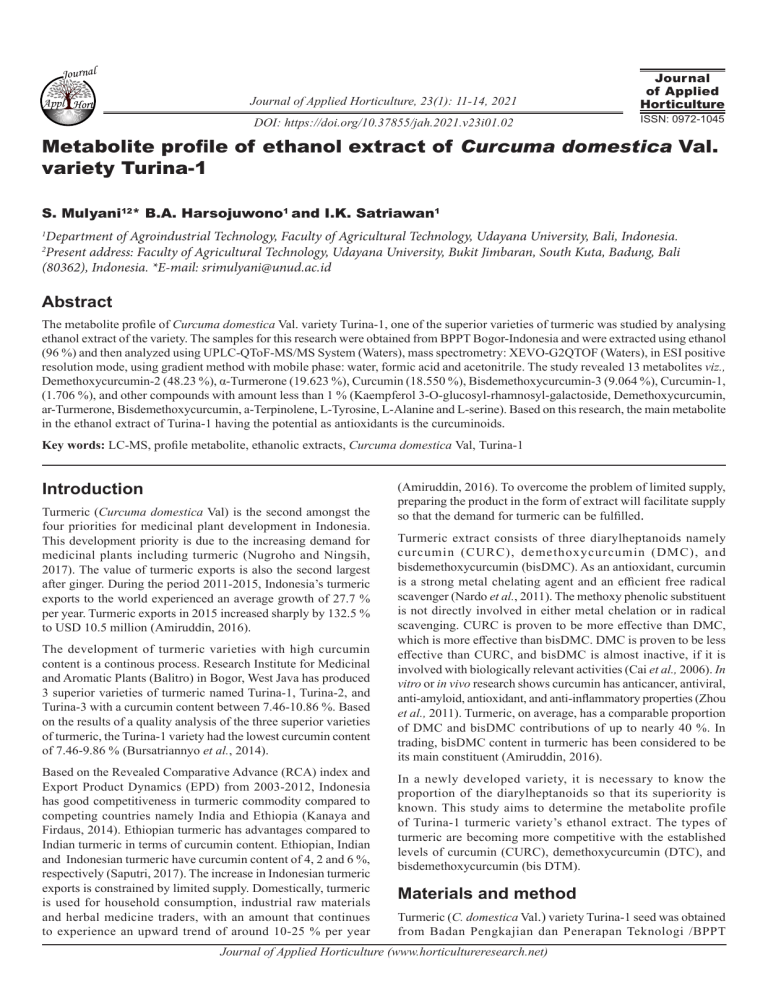
Journal Appl Journal of Applied Horticulture, 23(1): 11-14, 2021 Journal of Applied Horticulture DOI: https://doi.org/10.37855/jah.2021.v23i01.02 ISSN: 0972-1045 Metabolite profile of ethanol extract of Curcuma domestica Val. variety Turina-1 S. Mulyani12* B.A. Harsojuwono1 and I.K. Satriawan1 Department of Agroindustrial Technology, Faculty of Agricultural Technology, Udayana University, Bali, Indonesia. Present address: Faculty of Agricultural Technology, Udayana University, Bukit Jimbaran, South Kuta, Badung, Bali (80362), Indonesia. *E-mail: srimulyani@unud.ac.id 1 2 Abstract The metabolite profile of Curcuma domestica Val. variety Turina-1, one of the superior varieties of turmeric was studied by analysing ethanol extract of the variety. The samples for this research were obtained from BPPT Bogor-Indonesia and were extracted using ethanol (96 %) and then analyzed using UPLC-QToF-MS/MS System (Waters), mass spectrometry: XEVO-G2QTOF (Waters), in ESI positive resolution mode, using gradient method with mobile phase: water, formic acid and acetonitrile. The study revealed 13 metabolites viz., Demethoxycurcumin-2 (48.23 %), α-Turmerone (19.623 %), Curcumin (18.550 %), Bisdemethoxycurcumin-3 (9.064 %), Curcumin-1, (1.706 %), and other compounds with amount less than 1 % (Kaempferol 3-O-glucosyl-rhamnosyl-galactoside, Demethoxycurcumin, ar-Turmerone, Bisdemethoxycurcumin, a-Terpinolene, L-Tyrosine, L-Alanine and L-serine). Based on this research, the main metabolite in the ethanol extract of Turina-1 having the potential as antioxidants is the curcuminoids. Key words: LC-MS, profile metabolite, ethanolic extracts, Curcuma domestica Val, Turina-1 Introduction Turmeric (Curcuma domestica Val) is the second amongst the four priorities for medicinal plant development in Indonesia. This development priority is due to the increasing demand for medicinal plants including turmeric (Nugroho and Ningsih, 2017). The value of turmeric exports is also the second largest after ginger. During the period 2011-2015, Indonesia’s turmeric exports to the world experienced an average growth of 27.7 % per year. Turmeric exports in 2015 increased sharply by 132.5 % to USD 10.5 million (Amiruddin, 2016). The development of turmeric varieties with high curcumin content is a continous process. Research Institute for Medicinal and Aromatic Plants (Balitro) in Bogor, West Java has produced 3 superior varieties of turmeric named Turina-1, Turina-2, and Turina-3 with a curcumin content between 7.46-10.86 %. Based on the results of a quality analysis of the three superior varieties of turmeric, the Turina-1 variety had the lowest curcumin content of 7.46-9.86 % (Bursatriannyo et al., 2014). Based on the Revealed Comparative Advance (RCA) index and Export Product Dynamics (EPD) from 2003-2012, Indonesia has good competitiveness in turmeric commodity compared to competing countries namely India and Ethiopia (Kanaya and Firdaus, 2014). Ethiopian turmeric has advantages compared to Indian turmeric in terms of curcumin content. Ethiopian, Indian and Indonesian turmeric have curcumin content of 4, 2 and 6 %, respectively (Saputri, 2017). The increase in Indonesian turmeric exports is constrained by limited supply. Domestically, turmeric is used for household consumption, industrial raw materials and herbal medicine traders, with an amount that continues to experience an upward trend of around 10-25 % per year (Amiruddin, 2016). To overcome the problem of limited supply, preparing the product in the form of extract will facilitate supply so that the demand for turmeric can be fulfilled. Turmeric extract consists of three diarylheptanoids namely curcumin (CURC), demethoxycurcumin (DMC), and bisdemethoxycurcumin (bisDMC). As an antioxidant, curcumin is a strong metal chelating agent and an efficient free radical scavenger (Nardo et al., 2011). The methoxy phenolic substituent is not directly involved in either metal chelation or in radical scavenging. CURC is proven to be more effective than DMC, which is more effective than bisDMC. DMC is proven to be less effective than CURC, and bisDMC is almost inactive, if it is involved with biologically relevant activities (Cai et al., 2006). In vitro or in vivo research shows curcumin has anticancer, antiviral, anti-amyloid, antioxidant, and anti-inflammatory properties (Zhou et al., 2011). Turmeric, on average, has a comparable proportion of DMC and bisDMC contributions of up to nearly 40 %. In trading, bisDMC content in turmeric has been considered to be its main constituent (Amiruddin, 2016). In a newly developed variety, it is necessary to know the proportion of the diarylheptanoids so that its superiority is known. This study aims to determine the metabolite profile of Turina-1 turmeric variety’s ethanol extract. The types of turmeric are becoming more competitive with the established levels of curcumin (CURC), demethoxycurcumin (DTC), and bisdemethoxycurcumin (bis DTM). Materials and method Turmeric (C. domestica Val.) variety Turina-1 seed was obtained from Badan Pengkajian dan Penerapan Teknologi /BPPT Journal of Applied Horticulture (www.horticultureresearch.net) 12 Metabolite profile of ethanol extract of Curcuma domestica Val. variety Turina-1 (Agency for the Assessment and Application of Technology) Bogor, Indonesia. It was planted in experimental gardens in Antap Village, Candi Kuning, Tabanan, Bali, Indonesia. Crop was harvested at age of nine months. The chemicals used were ethanol (Brathaco Chemical), acetonitrile (Merck), formic acid (Merck), and aquadest. Preparation of turmeric extract: First, the turmeric was washed, drained and then sliced (±1 mm) and oven-dried at 55±2 °C until its water content reached a maximum of 10 %. The dried turmeric were powdered and sieved with 80 mesh, then macerated/soaked in ethanol (96 %) with a ratio of 1:6 for the powder and its solvent. The maceration process was conducted in 2 phases with each phase lasting for 24 hours. During each phase, the mixture was stirred twice. The filtrate was then separated using a rotary evaporator at 40 °C and a pressure of 100 m Bar. The endpoint for the ethanol evaporation process was when there was no longer dripping of the extract. Analysis: Identification of turmeric extract used LC-MS with specifications of UPLC-QToF-MS / MS System (Waters). Mass Lynk version software was used for processing data. Experimental conditions: LC Acuity UPLC BEH C.18 1.7 µm. 2.1 x 50 mm. Setting the tool temperature to 40 oC, flow Table 1. The gradient method used in separating ethanol extract of turmeric variety Turina-1 Time (min) A (%) Mobile phase B (%) 0 95 5 1 95 5 6 0 100 7 0 100 7.5 95 5 9 95 5 Note: A: H2O +0.1 % formic acid B: acetonitrile + 0.1 % formic acid rate of 0.3 mL/ min sample injection: 5 µL. The mobile phase were water, formic acid and acetonitrile with the gradient method as listed in Table 1. Mass spectroscopic conditions were as follows: XEVO - G2QTOF (Waters), the separation model was ESI model with the following conditions: 3 kV capillary voltage, 38 V sample voltage, desolation temperature of 300 oC, carrier temperature of 110 oC, gas velocity separation of 500 L / hour and gas cone speed of 16 L / hour. Identification was done by comparing the molecular weight of the compound with the data in the system bank using phenol explorer and data available in the literature (Herebian et al., 2009). Fig 1. LC-MS chromatogram of ethanol extract of turmeric variety Turina-1 Table 2. Identification of ethanol extract components of turmeric (C. domestica Val) variety Turina-1 using LC-MS Peak number 1 2 3 4 5 6 7 8 9 10 11 12 13 Compound L-serine L-Alanine a-Terpenolene Demethoxycurcumin Bisdemethoxycurcumin 3 Curcumin Demethoxycurcumin 2 α-Turmerone Curcumin 1 ar-Turmerone Bisdemethoxycurcumin L-Tyrosine Kaempferol 3-O-glucosylRhamnosyl-Galactoside Total Elemental composition C12H31NO3Si3 C9H23NO29H23NO2Si2 C10H16 C20H19O5 C13H11O3 C21H21O6 C8H7O C15H22O C17H17O4 C15H20O C19H17O4 C15H27NO3Si2 C33H40O20 Measured mass 321.287 233 136.109 119.109 215.070 285.112 119.109 218.166 285.112 216.151 309.112 325.192 756.549 Calculated mass 321 233 136 119.050 215.070 285.081 119.050 218.167 285.081 216.151 309.112 325 756.113 Retention Time 0.46 2.32 2.58 3.17 3.49 4.07 4.72 4.94 5.47 5.84 6.03 6.38 7.88 Relative area (%) 0.006 0.007 0.124 0.692 9.064 18.550 48.223 19.623 1.706 0.516 0.497 0.098 0.895 100 Journal of Applied Horticulture (www.horticultureresearch.net) Metabolite profile of ethanol extract of Curcuma domestica Val. variety Turina-1 Results and discussion Metabolite profile: Based on LC-MS (Liquid Chromatography Mass Spectroscopy) turmeric extract contains 13 constituent components as depicted in the chromatogram (Fig. 1). Thirteen components were identified and related parameters were determined (Table 2). The identified components from the ethanol extract of turmeric were: Demethoxycurcumin-2 (48.23 %), α-Turmerone (19,623 %), Curcumin (18,550 %), Bisdemethoxycurcumin-3 (9,064 %), Curcumin-1. (1,706 %) and other compounds with less than 1 % amount (Kaempferol 3-O-glucosyl-rhamnosyl-galactoside, desmethoxycurcumin, arTurmerone Bisdemethoxycurcumin, a-Terpinolene, L-Tyrosine and L-Alanine, L-serine). The results of the identification of components in this study are consistent with Herebian’s research (Herebian et al., 2009). It is known that there are about 235 phytochemicals in turmeric, especially phenolic compounds and terpenoids. The compounds that have been identified consist of 22 diarylheptanoids and diarylheptanoids classes, 8 phenylpropene and other phenolic groups, 68 monoterpenes, 109 groups of sesquiterpenes, 5 groups of diterpene, 3 groups of triterpenoids, 4 groups of sterols, 2 alkaloids and the other 14 groups combined (Herebian et al., 2009). Curcuminoids are a group of diarylheptanoids that are the main bioactive compounds of turmeric. The most common curcuminoid in turmeric is curcumin and has long been used for medicinal purposes. Curcumin has very low water solubility, thus limiting its use as an oral drug. Curcumin in the form of turmeric extract has an antiangiogenic effect five times higher than pure curcumin. This is due to the presence of other curcumin derivative components and other components contained in turmeric extract. Therefore, turmeric extract is stated to be more pharmacologically potential than pure curcumin (Liu et al., 2008). The low bioavailability of curcumin has been proven in clinical studies and animal experiments (Yue et al., 2012). The presence of lipophilic components (such as turmerone) in turmeric extract can affect the absorption of curcumin. Turmerone significantly increases curcumin transport into intestine cells so that absorption of curcumin increases significantly. Thus, giving turmeric extract containing turmerone is more effective in treating diseases than just curcumin. Curcuminoids in ethanol extract: Data in Table 3 indicate that turmeric ethanol extract contained curcuminoids consisting of curcumin (CUR). desmethoxycurcumin (DMC) and bisdemethoxycurcumin (bis-DMC), as well as essential oils that play an important role in subsequent reactions. Approximately, there are 25 essential oil compounds that have been found in turmeric extract. There are quantitative variations in each of the chemical components of essential oils depending on where the turmeric plant is grown (Jayaprakasha et al., 2006). The largest composition of curcuminoid in the extract is desmethoxycurcumin (DMC), and the smallest is Bisdemethoxycurcumin (bis-DMC) (Table 3). Why curcumin is more reactive than DMC and bis-DMC, so far the molecular reaction mechanism is not fully understood. This makes the curcumin content important in turmeric extract. Curcumin and its analogs are potential inhibitors of low-density 13 Table 3. Composition of curcuminoid ethanol extract of turmeric variety Turina-1 Compound Curcumin (CUR) Desmethoxycurcumin (DMC) Bisdemethoxycurcumin (bis-DMC) Total Amount (%) 25.73 62.13 12.14 100.00 lipoprotein oxidation, inhibitory reactions occur due to abstraction of H atoms from phenolic groups and possible involvement of 4-hydroxy-3-methoxyphenyl groups (Chen et al., 2006). The content of curcumin is important, given the antioxidant effect of each constituent. Although the molecular mechanism is not fully understood, it is clear that antioxidant activity is associated with electron withdrawal from the keto-enol group to the hydroxy-phenolic group, methoxy phenolic substitution also plays an important role (Chen et al., 2006). Curcumin is a powerful metal chelating agent and an efficient radical scavenger, metal chelating is carried out at the center of the keto-enol group (Somparn et al., 2007). Metabolite profile show that the major (87.986 %) content in the ethanolic extract of Turina-1 are curcuminoids which are potential antioxidants. The bis-DMC decay mechanism from steady-state (S1-state) is discussed and compared with curcumin using steady-state absorption and fluorescence techniques. The results show that differences in observed S1-state dynamics between bis-DMC and curcumin can be ascribed to differences in donor H-donor acceptors from donor phenolic OH and differences in the strength of intramolecular H bonds in keto-enol groups in two molecules (Nardo et al., 2011). Compared to other varieties of turmeric that currently exist in Indonesia, Turina-1 has a higher curcumin content. To produce curcumin levels > 7 %, this variety should be harvested at the minimum age of 9 months. Increasing the age of turmeric harvest from 9 months to 11 months did not significantly increase the content of curcumin with its content ranging from 7.0 to 7.59 % (Dewi et al., 2016). A total of 13 metabolites were characterised from ethanolic extracts of C. domestica Val, variety Turina-1. The composition of curcuminoid extract was curcumin (25.758 %), DMC (62.128 %) and Bis-DMC (12.144 %). Acknowledgments Our deepest gratitude is to the Ministry of Research, Technology, and Higher Education (RISTEKDIKTI) and the Institute for Research and Community Service (LPPM), Udayana University which has funded this research through Applied Research in 2019. References Amiruddin, A. 2016. Indonesian Turmeric in International Markets. https://inipasti.com/kunyit-indonesia-di-pasar-internasional/. Bursatriannyo, Syukur, C. and Mushthofa, 2014. Identification of Turmeric Variety Using Expert System https://www.researchgate. net/publication/320062940_IDENTIFIKASI_VARIETAS_ TANAMAN_KUNYIT_MENGGUNAKAN_SISTEM_PAKAR Cai, Y.Z, M. Sun, J. Xing, Q. Luo, and H. Corke, 2006. Structure–radical scavenging activity relationships of phenolic compounds from traditional Chinese medicinal plants. J. life Sci., 78(25):2872-88. Journal of Applied Horticulture (www.horticultureresearch.net) 14 Metabolite profile of ethanol extract of Curcuma domestica Val. variety Turina-1 Chen, W.F., S.L. Deng, B. Zhou, L. Yang and Z.L. Liu, 2006. Curcumin and its analogues as potent inhibitors of low-density lipoprotein oxidation: H-atom abstraction from the phenolic groups and possible involvement of the 4-hydroxy-3-methoxyphenyl groups. JFRB, Medicine, 40(3): 526-35. Dewi, P.J.N., A. Hartiati and S. Mulyani, 2016. The effect of harvest age and maceration level on curcumin content and antioxidant activity of turmeric extract (Curcuma domestica Val.). J. Rekayasa Mgt. Agroindustri, 4(3): 105-15. Herebian, D., J.H. Choi, A.M. Abd El-Aty, J.H. Shim and M. Spiteller, 2009. Metabolite analysis in Curcuma domestica using various GC-MS and LC-MS separation and detection techniques. Biomed. Chromatogr., 23(9): 951-65. Jayaprakasha, G., L.J.M. Rao and K. K. Sakariah, 2006. Antioxidant activities of curcumin, demethoxycurcumin and bisdemethoxycurcumin. Food Chem., 98(4): 720-24 Kanaya, I.A. and M. Firdaus, 2014. Competitiveness and demand for export of Indonesian biopharmaca products in main destination countries period 2003-2012. J. Mgt. Agrib., 11(3): 183-198 Liu, D., J. Schwimer, Z. Liu, E.A. Woltering and F.L. Greenway, 2008. Antiangiogenic effect of curcumin in pure versus in extract forms. Pharmaceutical Biol., 46(10-11): 677-82. Nardo, L., A. Andreoni, M. Masson, T. Haukvik and H.H. Tønnesen, 2011. Studies on curcumin and curcuminoids. XXXIX. Photophysical properties of bisdemethoxycurcumin. J. Fluorescence, 21(2): 627-35. Nugroho, R.A. and E.A. Ningsih, 2017. Info on Commodities of Medicinal Plants. In: Medicinal Plants Production, Z. Salim and E. Munadi (eds.). p.9-20. http://bppp.kemendag.go.id/media_ content/2017/12/Isi_BRIK_Tanaman_Obat.pdf. Saputri, A.S. 2017. Foreign Trade of Medicinal Plants. In: Medicinal Plants Production, Z. Salim and E. Munadi (eds.). p.49-64. http:// bppp.kemendag.go.id/media_content/2017/12/Isi_BRIK_Tanaman_ Obat.pdf. Somparn, P., C. Phisalaphong, S. Nakornchai, S. Unchern and N. Morales, 2007. Comparative antioxidant activities of curcumin and its demethoxy and hydrogenated derivatives. Biol. Pharmaceutical Bull., 30(1): 74-8. Yue, G.G., S.W. Cheng, H. Yu, Z.S. Xu, J.K. Lee and P.M. Hon, 2012. The role of turmerones on curcumin transportation and P-glycoprotein activities in intestinal Caco-2 cells. J. Medicinal Food, 15(3): 242-52. Zhou, H., C.S. Beevers and S. Huang, 2011. The targets of curcumin. Curr Drug Targets, 12(3): 332-47. Received: August, 2020; Revised: September, 2020; Accepted: November, 2020 Journal of Applied Horticulture (www.horticultureresearch.net)
